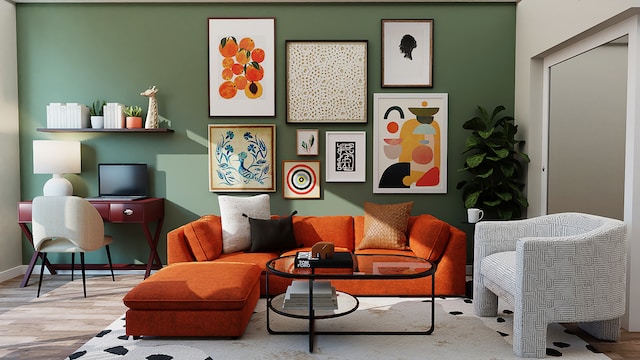Are you tired of the same old look in your home? Do you want to add intrigue and personality to space? Look no further than incorporating art into your interior design. Art has the power to transform a room by adding color, texture, and visual appeal. In this blog, we’ll explore the basics of art in design and provide tips on how to incorporate different types of artwork into your space to transform your interior.
Understanding the Basics of Art in Design
Before diving into the world of art in design, it’s important to understand the basics. Elements of art, such as color, line, shape, and form, are the building blocks of visual art. Principles of design, such as balance, contrast, harmony, and rhythm, are the tools artists use to create compositions. When choosing artwork for your space, consider elements of art that complement your style and principles of design that create balance and interest.
Types of Artwork to Consider
When it comes to incorporating art into your space, there are many different types of artwork to choose from. Paintings and prints are a popular option, as they come in a variety of styles, sizes, and price points. The team at shinyprints.com recommend metal prints, as this popular artwork type offers a modern and sleek look that can complement various interior design styles. To get a more extensive reference for your artwork options visit websites that offer a range of metal prints, as well as other types of artwork.
In addition to metal prints, paintings are a classic option that comes in various styles, sizes, and price points. Sculptures and wall hangings can add dimension and texture to a room, while mixed media and installations can create a sense of whimsy and uniqueness. For those who enjoy DIY projects, creating your artwork can be fun and personal to add character to your space.
Choosing Artwork to Fit Your Style
When selecting artwork for your home, it’s important to choose pieces that fit with your individual style. If you have a minimalist aesthetic, for example, you might choose simple, monochromatic pieces that blend seamlessly with your decor. If your style is more eclectic, you might opt for bold, colorful pieces that create visual interest and intrigue.
Scale, Placement, and Lighting
Another important consideration when incorporating artwork into your space is scale, placement, and lighting. Scale refers to the size of the artwork relative to the size of the room and other objects in the space. A large painting, for example, can create a sense of drama and grandeur in a space, while a small sculpture can add subtle interest. Placement refers to the physical location of the artwork within the room, such as on a wall, above a fireplace, or on a shelf. Lighting is also a critical component, as different types of lighting can affect the color, texture, and visibility of artwork.
Mixing and Matching Artwork
Once you’ve chosen your artwork, it’s important to consider how to mix and match pieces for a cohesive look. Mixing different styles and mediums can create visual interest and depth while balancing neutrals and bold colors can ensure a harmonious overall effect. Grouping and layering artwork is another technique that can create a dynamic and visually appealing display.
Incorporating Art into Your Space
Art can be incorporated into any room in your home, from living rooms and bedrooms to kitchens and dining areas. In living rooms, consider creating a gallery wall with a mix of paintings, prints, and photographs. In bedrooms, focus on creating a peaceful and serene atmosphere with calming colors and abstract or nature-themed artwork. In kitchens and dining areas, consider adding a statement piece above the table or placing sculptures or glassware on shelves or countertops. In home offices and workspaces, artwork can add inspiration and motivation, while in hallways and entryways, it can create a welcoming and inviting atmosphere.
Tips for Displaying Your Artwork
Once you’ve chosen your artwork and decided where to incorporate it into your space, it’s important to display it properly. Hanging and framing techniques can make all the difference, as can grouping and layering artwork to create a sense of flow and balance. Creating gallery walls and focal points can also add interest and intrigue to your space.
Using Art to Transform Your Space
Real-life examples of how art can transform a room abound, from before and after photos to case studies. Whether you choose a single statement piece or create a curated collection of artwork, incorporating art into your interior design can add character, personality, and visual appeal to any room in your home.
Incorporating art into your interior design is a powerful way to revamp your space and add interest and personality. By understanding the basics of art in design, choosing artwork that fits with your style, and considering scale, placement, and lighting, you can create a visually appealing and cohesive display. Whether you opt for paintings and prints, sculptures and wall hangings, mixed media and installations, or DIY projects, the possibilities for transforming your space with art are endless.


